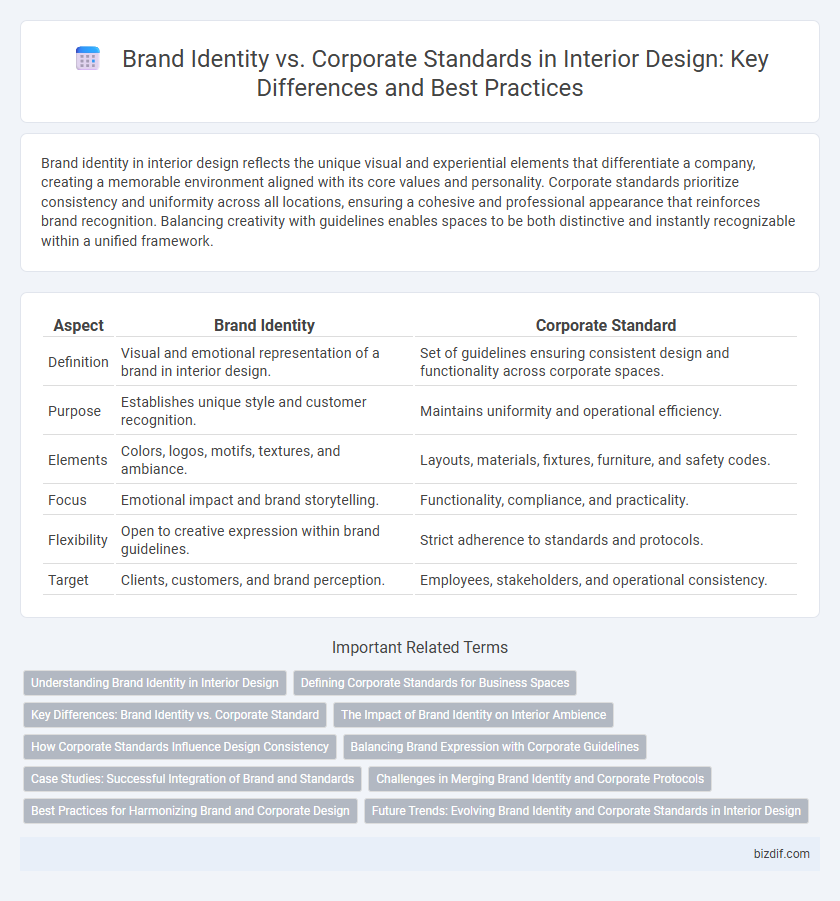Brand identity in interior design reflects the unique visual and experiential elements that differentiate a company, creating a memorable environment aligned with its core values and personality. Corporate standards prioritize consistency and uniformity across all locations, ensuring a cohesive and professional appearance that reinforces brand recognition. Balancing creativity with guidelines enables spaces to be both distinctive and instantly recognizable within a unified framework.
Table of Comparison
| Aspect | Brand Identity | Corporate Standard |
|---|---|---|
| Definition | Visual and emotional representation of a brand in interior design. | Set of guidelines ensuring consistent design and functionality across corporate spaces. |
| Purpose | Establishes unique style and customer recognition. | Maintains uniformity and operational efficiency. |
| Elements | Colors, logos, motifs, textures, and ambiance. | Layouts, materials, fixtures, furniture, and safety codes. |
| Focus | Emotional impact and brand storytelling. | Functionality, compliance, and practicality. |
| Flexibility | Open to creative expression within brand guidelines. | Strict adherence to standards and protocols. |
| Target | Clients, customers, and brand perception. | Employees, stakeholders, and operational consistency. |
Understanding Brand Identity in Interior Design
Brand identity in interior design encompasses the unique visual elements, color schemes, and spatial layouts that reflect a company's personality and values, creating an immersive experience for clients and employees. Unlike corporate standards, which set uniform guidelines for consistency across locations, brand identity emphasizes emotional connections and storytelling through design details and material choices. Understanding brand identity allows designers to craft environments that reinforce brand recognition and loyalty, driving deeper engagement and a cohesive brand narrative.
Defining Corporate Standards for Business Spaces
Defining corporate standards for business spaces involves establishing consistent design elements such as color schemes, materials, and furniture styles that reflect the brand identity across all locations. These standards ensure a cohesive and professional environment that reinforces brand recognition while supporting functionality and employee productivity. Clear guidelines on spatial layout, lighting, and signage help maintain uniformity and create a strong visual statement aligned with the company's core values.
Key Differences: Brand Identity vs. Corporate Standard
Brand identity in interior design emphasizes the visual and emotional elements that convey a company's unique personality through colors, logos, and thematic decor, creating a memorable customer experience. Corporate standard focuses on consistent operational guidelines and functional design criteria to ensure uniformity, efficiency, and adherence to company policies across all locations. The key difference lies in brand identity driving emotional engagement and differentiation, while corporate standard ensures practical consistency and brand conformity.
The Impact of Brand Identity on Interior Ambience
Brand identity profoundly shapes interior ambience by embedding visual elements, color schemes, and design motifs that reflect the company's ethos and values. This customization creates a cohesive sensory experience, fostering emotional connections and brand recognition among clients and employees. Corporate standards ensure consistency across locations but integrating brand identity within interiors amplifies uniqueness and strengthens the overall customer experience.
How Corporate Standards Influence Design Consistency
Corporate standards create a framework that ensures design consistency across all interior spaces by defining specific guidelines for color schemes, materials, lighting, and furniture selection. These standards help maintain a cohesive visual identity that aligns with the brand's core values and messaging, reinforcing recognition and trust among customers and employees. Consistent application of corporate standards reduces design discrepancies, streamlines project execution, and enhances the overall user experience in commercial environments.
Balancing Brand Expression with Corporate Guidelines
Balancing brand expression with corporate guidelines in interior design ensures a cohesive environment that reflects the brand's unique identity while adhering to established corporate standards. Integrating customized elements like color schemes, textures, and furnishings within a framework of approved materials and layouts promotes consistency and reinforces brand recognition. This approach creates immersive spaces that resonate with both employees and clients, merging creativity with operational efficiency.
Case Studies: Successful Integration of Brand and Standards
Case studies in interior design reveal how integrating brand identity with corporate standards enhances both aesthetics and functionality, aligning spatial experiences with organizational values. Notable projects demonstrate that consistent use of branded elements, such as color schemes, materials, and signage, within established corporate guidelines fosters cohesive environments that reinforce brand recognition and employee engagement. Examples from leading firms illustrate that balancing creativity with adherence to standards ensures scalable designs adaptable across multiple locations while preserving unique brand storytelling.
Challenges in Merging Brand Identity and Corporate Protocols
Merging brand identity with corporate standards presents challenges such as maintaining creative expression while adhering to strict design guidelines and operational protocols. Interior designers must balance aesthetic innovation with functional consistency to reflect both the brand's personality and the company's regulatory requirements. Conflicts often arise in aligning unique brand elements with corporate mandates on materials, color schemes, and spatial layouts, requiring strategic compromise and collaboration.
Best Practices for Harmonizing Brand and Corporate Design
Effective interior design balances brand identity and corporate standards by integrating distinctive brand elements with universal corporate guidelines to create cohesive environments. Consistent use of color palettes, typography, and branded materials ensures recognition while adhering to company policies supports functionality and professionalism. Prioritizing collaboration between design teams and brand strategists enhances spatial storytelling, aligning aesthetics with corporate values for maximum impact.
Future Trends: Evolving Brand Identity and Corporate Standards in Interior Design
Evolving brand identity in interior design emphasizes personalized, immersive environments that reflect a company's unique values and culture, moving beyond rigid corporate standards. Future trends highlight adaptive, flexible design elements integrating sustainability, technology, and wellness to foster authentic brand experiences. These shifts redefine corporate standards, prioritizing innovation and employee well-being while maintaining cohesive visual and functional consistency.
Brand identity vs Corporate standard Infographic

 bizdif.com
bizdif.com